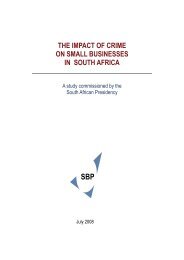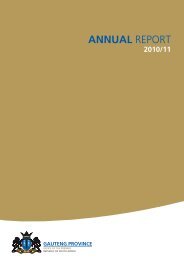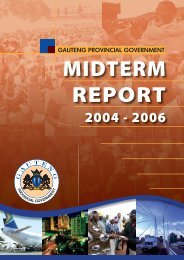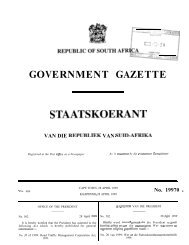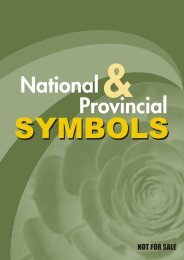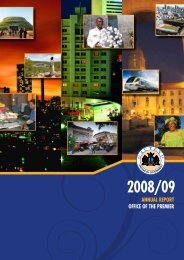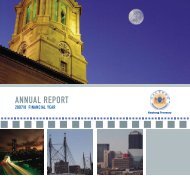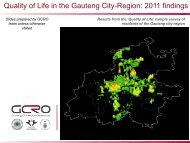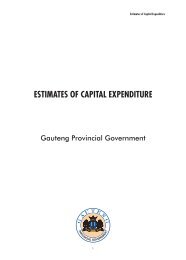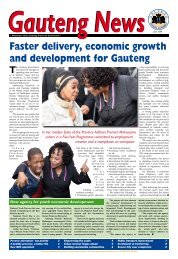the gauteng spatial development framework - Gauteng Online
the gauteng spatial development framework - Gauteng Online
the gauteng spatial development framework - Gauteng Online
You also want an ePaper? Increase the reach of your titles
YUMPU automatically turns print PDFs into web optimized ePapers that Google loves.
URBAN CONSOLIDATION ZONESThe physical nature of an urban corridor realises a complex interweave of point-related andextensive district uses. This in turn forms a complex interrelationship of urban scale and'local', 'neighbourhood', 'district' and 'metropolitan' identities, without very extensive 'turfs'.Within this urban milieu a very complex range of socio-economic profiles are establishedand enabled to coexist in a mutually supportive manner: The principles governing urbanconsolidation within <strong>the</strong> GCR.Urban consolidation aims at increasing <strong>the</strong> gross densities at which people are accommodatedwithin <strong>the</strong> GCR and intensifying, in more complex <strong>development</strong> patterns, <strong>the</strong> way in which<strong>the</strong> urban system works.Urban consolidation is directed into and around existing primary urban centres, urban nodes,urban corridors and along urban activity spines.• There is a predisposition to being encouraging of urban <strong>development</strong>;• There is a requirement to increase <strong>the</strong> complexity of <strong>the</strong> socio-economic and demographicprofile of people being attracted to live and work in <strong>the</strong>se areas;• Residential densities should not be less than of a medium nature and encouraged tobe higher than this;• Residential housing types are to reflect a range of options commensurate with <strong>the</strong>higher densities being sought;• Patterns of activity should be complex in <strong>the</strong>ir profile and single-use <strong>development</strong>s arediscouraged;ANNEXURE C: POLICY PERSPECTIVESWhere urban systems are particularly complex in <strong>the</strong>ir morphology (i.e. <strong>the</strong>y comprise severaloverlapping morphological types), an 'urban consolidation zone' has been defined.The above morphological types and zones have been defined (a) in relation to existing,naturally-occurring positions (having been satisfied that <strong>the</strong>se are consistent with urbanfundamentals and will fur<strong>the</strong>r <strong>the</strong> intentions of urban restructuring); (b) ensuring that <strong>the</strong>yare already, or are capable of being served by sustainable public transport; (c) make use ofexisting infrastructure and/or are in areas where infrastructure can sensibly be augmented;(d) assist in regionalising existing <strong>spatial</strong>ly marginalised communities. The defined urbanconsolidation zones for <strong>the</strong> GCR are seen in Figure C.4.1.Where <strong>development</strong> proposals are contemplated in <strong>the</strong> above morphological types or zones(o<strong>the</strong>r than where <strong>the</strong> size of an application is of such minor and inconsequential scale andnature as to make <strong>the</strong>se considerations trite), <strong>the</strong> following urban management considerationsapply:• Where non-residential uses are included in <strong>the</strong> application, <strong>development</strong> intensities (i.e.floor area ratios or FARs) are to be moderate to high (<strong>the</strong> specification of FAR beingcommensurate with <strong>the</strong> morphological type involved);• Gated communities or separation of enclaves from <strong>the</strong>ir surroundings through exclusivityof access or residential right is not permitted;• Local management associations along <strong>the</strong> lines of urban improvement precincts (UIPs)are permitted within <strong>the</strong> prevailing policy context of municipalities in order toenhance maintenance, cleansing, landscaping and security;• The 'walkability' of a <strong>development</strong> (i.e. <strong>the</strong> need for commuting to have beenreduced and <strong>the</strong> ability of people to get around by non-motorised movement NMM)needs to be demonstrated; and• The ease of safe, convenient access to public transport must be demonstrated.173 GAUTENG SPATIAL DEVELOPMENT FRAMEWORK 2011 GAUTENG GROWTH AND DEVELOPMENT AGENCY



